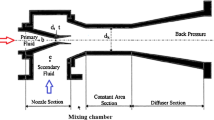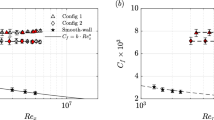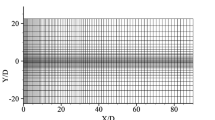Abstract
The paper presents the numerical simulation results of the surface roughness influence on gas-dynamic processes inside flow parts of a supersonic ejector. These simulations are performed using two commercial CFD solvers (Star- CCM+ and Fluent). The results are compared to each other and verified by a full-scale experiment in terms of global flow parameters (the entrainment ratio: the ratio between secondary to primary mass flow rate - ER hereafter) and local flow parameters distribution (the static pressure distribution along the mixing chamber and diffuser walls). A detailed comparative study of the employed methods and approaches in both CFD packages is carried out in order to estimate the roughness effect on the logarithmic law velocity distribution inside the boundary layer. Influence of the surface roughness is compared with the influence of the backpressure (static pressure at the ejector outlet). It has been found out that increasing either the ejector backpressure or the surface roughness height, the shock position displaces upstream. Moreover, the numerical simulation results of an ejector with rough walls in the both CFD solvers are well quantitatively agreed with each other in terms of the mean ER and well qualitatively agree in terms of the local flow parameters distribution. It is found out that in the case of exceeding the “critical roughness height” for the given boundary conditions and ejector’s geometry, the ejector switches to the “off-design” mode and its performance decreases considerably.
Similar content being viewed by others
References
E.Ya. Sokolov and N.M. Zinger, Jet Apparatuses, Energoatomizdat, Moscow, 1989.
V.G. Tsegelsky, Two-phase jet apparatuses, Moscow State Techn. Univ. named after Bauman, Moscow, 2003.
ESDU No. 86030. Ejectors and jet pumps. Design for steam driven flow, 1986.
F. Mazzelli and A. Milazzo, Performance analysis of a supersonic ejector cycle working with R245fa, Int. J. Refrigeration, 2015. Vol. 49, P. 79–92.
F. Menter, J.C. Ferreira, T. Esch, and B. Konno, The SST turbulence model with improved wall treatment for heat transfer predictions in gas turbines, in: Proc. Int. Gas Turbine Congress, Tokyo, 2003. P. 1–7.
Y. Bartosiewicz, Z. Aidoun, P. Desevaux, and Y. Mercadier, CFD-experiments integration in the evaluation of six turbulence models for supersonic ejectors modeling, in: Conf. Proc., Integrating CFD and Experiments, Glasgow, UK, 2003. P. 561–566.
Y. Bartosiewicz, Z. Aidoun, P. Desevaux, and Y. Mercadier, Numerical and experimental investigations on supersonic ejectors, Int. J. Heat Fluid Flow, 2005. No. 26, P. 56–70.
P. Colonna, S. Harincks, S. Rebay, and A. Guardone, Real-gas effects in organic Rankine cycle turbine nozzles, J. Propulsion and Power, 2008. Vol. 24, No. 2, P. 282–294.
L.M. Lujan, R. Serrano, V. Dolz, and J. Sanchez, Model approximation to an equation of state for the R245fa fluid in an expansion process, J. Appl. Thermal Engng, 2012. Vol. 40, P. 248–257.
NIST Chemistry WebBook, NIST Standard Reference Database Number 69, 2003. http://www.webbook.nist.gov/chemistry.
T. Knopp, B. Eisfeld, and J.B. Calvo, A new extension for k–ω turbulence models to account for wall roughness, Int. J. Heat Fluid Flow, 2009. Vol. 30, P. 54–65.
CD-Adapco Star-SSM+ documentation help.
Ansys Fluent documentation help.
J. Nikuradse, Laws of Flow in Rough Pipes, NACA, Washington, 1950. Technical Memorandum 1292.
H. Schlichting, Boundary Layer Theory, 6th Edition, McGraw Hill, New York, 1968.
T. Cebeci and P. Bradshaw, Momentum Transfer in Boundary Layers, Hemisphere Publ. Corp., N.Y., 1977.
T. Adams, C. Grant, and H. Watson, A simple algorithm to relate measured surface roughness to equivalent sand-grain roughness, Int. J. Mech. Engng Mechatron, 2012. No. 1, P. 66–71.
M.V. Zagarola and A.J. Smits, Mean-flow scaling of turbulent pipe flow, J. Fluid Mech., 1998. Vol. 373, P. 33–79.
A.V. Sobolev, V.I. Zapryagaev, and V.M. Malkov, Single-stage ejector with high compression ratio, Thermophysics and Aeromechanics, 2005. Vol. 12, No. 1, P. 141–150.
Author information
Authors and Affiliations
Corresponding author
Rights and permissions
About this article
Cite this article
Brezgin, D.V., Aronson, K.E., Mazzelli, F. et al. The surface roughness effect on the performance of supersonic ejectors. Thermophys. Aeromech. 24, 553–561 (2017). https://doi.org/10.1134/S0869864317040060
Received:
Revised:
Published:
Issue Date:
DOI: https://doi.org/10.1134/S0869864317040060




